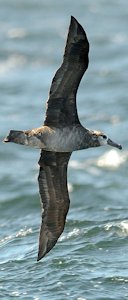
|
Soaring Seabirds in Bird Flight - Page 1
Quite different physical principles underlie the soaring flight of seabirds, such as albatrosses, large petrels, and shearwaters. There are no thermals or updrafts over large bodies of water, only horizontal gusts of wind. The air masses that these gusts drive before them are slowed by friction at the water surface, and their speed is consequently slower than in higher altitudes. These seabirds have developed a type of soaring and gliding that does not depend upon the presence of either thermal or obstruction currents. Seabirds use the differential wind velocities that occur over the sea for their soaring flight. Albatrosses, for example, take off against the wind, rising without beating their wings, until they lose momentum in the faster-moving layers of air farther from the water surface, at the height of about 35 to 65 feet. The birds then turn in a curve and shoot back to the water surface in an oblique gliding path, gaining so much speed that after turning back again they can once more climb against the wind. In this way albatrosses cab soar for hours and days at a time without ever beating their wings. Ornithologists call this "dynamic soaring" or "gust flying" --- rising into the gust and falling on the lull. It is this seemingly endless form of flying that allows the albatross to survive, since albatrosses cannot fly in the absence of wind. This is a significant factor in their latitudinal distribution. Here for a Dynamic Soaring Flight Diagram On to Soaring Seabirds Page 2 ⇨ |
| Laysan Albatross | |